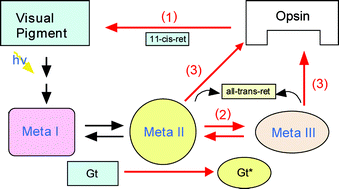Molecular properties of rod and cone visual pigments from purified chicken cone pigments to mouse rhodopsin in situ†
Abstract
We have investigated the molecular properties of rod and cone visual pigments to elucidate the differences in the molecular mechanism(s) of the photoresponses between rod and cone photoreceptor cells. We have found that the cone pigments exhibit a faster pigment regeneration and faster decay of meta-II and meta-III intermediates than the rod pigment, rhodopsin. Mutagenesis experiments have revealed that the amino acid residues at positions 122 and 189 in the opsins are the determinants for these differences. In order to study the relationship between the molecular properties of visual pigments and the physiology of rod photoreceptors, we used mouse rhodopsin as a model pigment because, by gene-targeting, the spectral properties of the pigment can be directly correlated to the physiology of the cells. In the present paper, we summarize the spectroscopic properties of cone pigments and describe our studies with mouse rhodopsin utilizing a high performance

- This article is part of the themed collection: 14th International Congress on Photobiology, Korea

 Please wait while we load your content...
Please wait while we load your content...